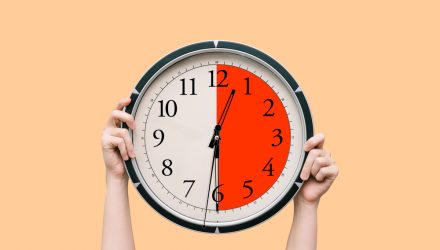The second half of 2023 could bring an array of fixed income opportunities, but just how good those opportunities prove lies heavily with the Federal Reserve’s plans for interest rates and whether or not the U.S. economy averts a recession.
Entering the final six months of the year, the prevailing wisdom is that the economy will dodge a traditional recession and that the Fed may raise rates just once or twice to the tune of 25 basis points each time. Still, many bond market observers are extoling a second half preference for investment-grade debt, and that could be a bonus for exchange traded funds such as the Calvert Ultra-Short Investment Grade ETF (NYSE Arca: CVSB).
There are several reasons why CVSB could be a winner among corporate bond ETFs in the July through December period. Notably, what market observers believe will happen today might not play out over the coming months. Said another way, it’s possible that the Fed surprises with more rate hikes or that a recession arrives.
The first scenario would highlight advantages of CVSB’s ultra-short status. Meanwhile, an economic slump would likely punish junk bonds, which don’t reside in the ETF.
CVSB Compelling Second Half Idea
The Calvert ETF may find additional tailwinds in the months ahead.
“Although risks are skewed to the downside in the recession bear case scenario to 200 basis points. We think the banking space looks cheap versus the market, especially money center banks,” noted Vishy Tirupattur, Morgan Stanley’s chief fixed income strategist. “We favor single A’s or triple B’s and shortening of portfolio duration. Our preference is to own the front end of the curve within the investment graded space.”
CVSB easily checks the strong credit quality box. The fund allocates over 62% of its weight to bonds rated AAA, AA, or A. Additionally, CVSB is actively managed. This indicates that if the credit cycle turns sour, it can more rapidly skew its lineup to higher-quality fare than passively managed rivals.
That’s a relevant trait because the longer the Fed goes without signaling a reduction in interest rates, the more stress junk borrowers incur.
“Higher for longer puts more pressure on lower quality borrowers. While the macro outlook is not acutely challenging for credit, it progressively erodes debt affordability,” concluded Tirupattur. “For larger and higher quality borrowers, we expect the net impact to be gradual decline in interest coverage ratios and a voluntary focus on right sizing balance sheets. For smaller and lower quality companies, this adjustment could well be disruptive as 2025 maturity walls come into view.”
Investors interested in these traits can consider CVSB for their portfolios.
For more news, information, and analysis, visit the Responsible Investing Channel.

